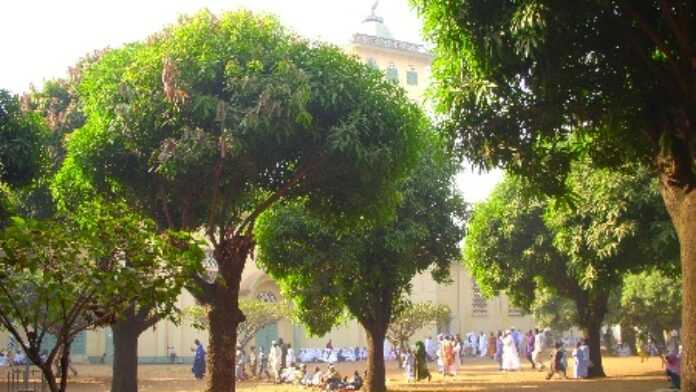
The saying, “it’s the thought that counts,” sounds generous and openhearted in the United States. It sounds laughable in Africa, at least at Tabaski. A better saying, to use a British slang term for food, might be, “It’s the tuck that counts”—along with the clothes, kids, company, and conversation. Tabaski is all in the doing. The Letter of James comes to mind: “I will show you my faith by my works.”
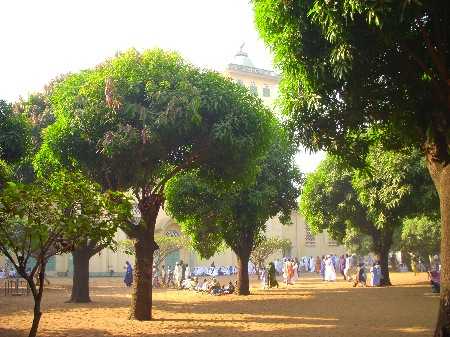 But this year’s Tabaski in Bamako started out for me as just a thought. I was alone in the room I’ve been renting at a missionary guesthouse. Although I’ve been studying the N’ko alphabet since arriving here in late October, no one I’d met through my studies had invited me to their home. I was in a melancholy mood, wondering what I’d accomplished over the past thirty days.
But this year’s Tabaski in Bamako started out for me as just a thought. I was alone in the room I’ve been renting at a missionary guesthouse. Although I’ve been studying the N’ko alphabet since arriving here in late October, no one I’d met through my studies had invited me to their home. I was in a melancholy mood, wondering what I’d accomplished over the past thirty days.
Things were different in Kankan, Guinea last year, I thought, where I’d begun studying the N’ko alphabet. I waxed nostalgic.
I woke early on Tabaski 2008 and went to meet my friend Sidiki Camara in his family’s compound. Sidiki and I had met while studying N’ko together in a shack next to the auto repair shop of our teacher, Kèmo Kanté. Sidiki had invited me to spend Tabaski with his family.
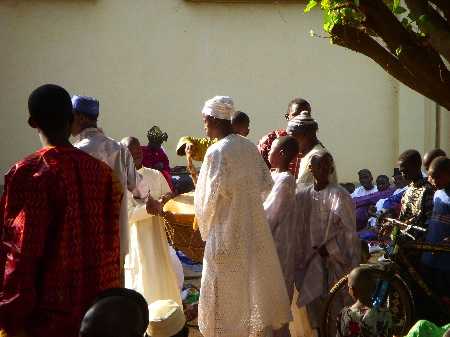 The day began with a trip to Kankan’s grand mosque (see photo 1) with several of Sidiki’s male relatives. We stopped along the way to watch a procession of Kankan’s notables enter the mosque’s grounds.
The day began with a trip to Kankan’s grand mosque (see photo 1) with several of Sidiki’s male relatives. We stopped along the way to watch a procession of Kankan’s notables enter the mosque’s grounds.
An attendant held an umbrella over them as they walked. A young man and a boy beat a large, round, wooden drum (see photo 2) to announce their arrival. They hit two, deep, resounding beats quickly—one after the other—followed by a lengthy pause before they repeated the beats, over and over until the notables had seated themselves beneath an open-air shelter in the mosque’s mango grove.
Here the grand imam gave his sermon (see photo 3), reading from the text he had prepared in Arabic. Avid listeners recorded his words. Two armed soldiers stood by as crowd control, I imagined, for a crowd that hardly needed any.
I sat next to Sidiki throughout the sermon (see photo 4) and imitated him and the men in front of me as they did their rakats at prayer time. Somehow I managed not to trip on my boubou (pronounced “boo-BOO”), the long garment I wore as I bent, knelt, and stood to pray.
Afterward, at Sidiki’s compound, Sidiki and several male relatives cut the throats of two rams, letting the blood spill into a hole in the center of the compound (see photo 5).
We then ate the meat together. I received a huge chunk. It was enough for two people, but I did not want to disappoint. I ate as much as I could.
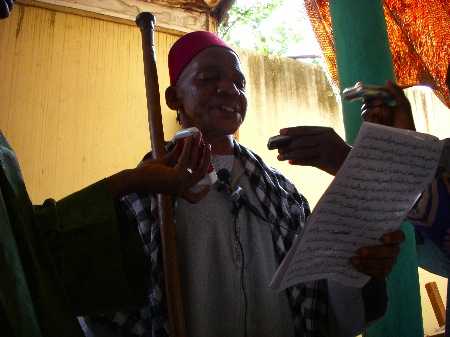 Then, for three days following Tabaski, Kankan hosted the Mamaya, the most spectacular Tabaski celebration I have ever seen. The city blocked off the Carrefour Chérifoula (“car-FOOR shay-ree-foo-LAH,” an intersection) to traffic beneath the second-storey studio of Radio Milo FM. It raised a stage for a band and held a glamorous, slow moving dance that involved hundreds of dancers who had practiced throughout the year in neighborhood clubs for the event (see photo 6).
Then, for three days following Tabaski, Kankan hosted the Mamaya, the most spectacular Tabaski celebration I have ever seen. The city blocked off the Carrefour Chérifoula (“car-FOOR shay-ree-foo-LAH,” an intersection) to traffic beneath the second-storey studio of Radio Milo FM. It raised a stage for a band and held a glamorous, slow moving dance that involved hundreds of dancers who had practiced throughout the year in neighborhood clubs for the event (see photo 6).
The dance takes skill and grace. Long lines of women or men run parallel to each other, interweave, or pass each other going in opposite directions. In the apparent chaos is a persistent, delicate ballet that foregrounds the complex intricacy of love, difference, and interdependence between men and women.
Mamaya dancers outshine everyone’s efforts to dress well on Tabaski. Each day of the dance, they wear costumes of a different, shared color. Women’s hair, jewelry, makeup, and shoes compliment their hand-tailored clothes. Men wear white caps and sport canes or handkerchiefs which they twirl as they move. Griots sing to lavish praises upon them.
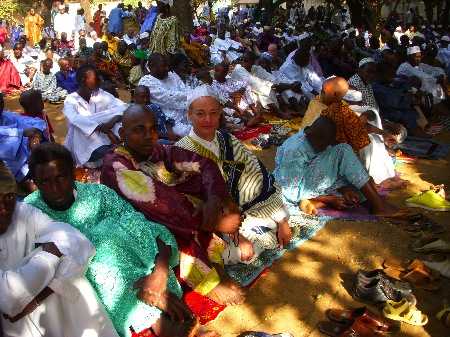 The impression is of a human kaleidoscope, set in motion by the world’s rotation, reflecting its color, light, and even shadows as night falls on the dance grounds. Mamaya performs a majestically suggestive display of the desire that keeps the world turning—and Tabaski returning—to Kankan year after year, generation after generation.
The impression is of a human kaleidoscope, set in motion by the world’s rotation, reflecting its color, light, and even shadows as night falls on the dance grounds. Mamaya performs a majestically suggestive display of the desire that keeps the world turning—and Tabaski returning—to Kankan year after year, generation after generation.
Then, back in Bamako, a phone call interrupted my reverie. It was my friend Issa Sidibé whom I’d met through my N’ko classes (He appears in a photo in my earlier column on N’ko). He offered to pick me up on his motorcycle and take me to his home for lunch. Tabaski is foolproof.
Afterward, he drove me to the homes of two different friends of mine, as well as to my N’ko teacher’s home, to deliver holiday greetings. At my friends’ homes we were met with a monstrous array of food and drink: mutton, fonio, rice, peanut sauce, fried plantains, French fries, bananas, oranges, and soft drinks. Our hosts were not rich by any means, but a thought means nothing if it feeds no one.
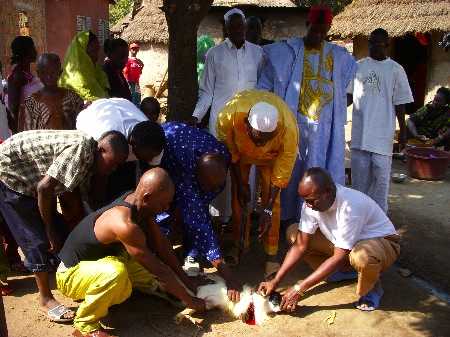 Issa and I made our way between these cornucopias of gastronomic excess amid beautifully clad people in shiny, starched, and colorful bazin cloth. Little girls wore dresses that fell to their ankles. A little boy in suit coat and trousers led his even smaller sister by the hand on a dirt road on the Colline du Savoir (‘Hill of Knowledge’) in the working-class neighbourhood behind the University. They walked purposefully to one end of a laterite dirt road before returning back to where they’d started. Just to sport their finery, astonishingly unaccompanied by their own adults, unthinkable in the United States. Other adults surrounded them.
Issa and I made our way between these cornucopias of gastronomic excess amid beautifully clad people in shiny, starched, and colorful bazin cloth. Little girls wore dresses that fell to their ankles. A little boy in suit coat and trousers led his even smaller sister by the hand on a dirt road on the Colline du Savoir (‘Hill of Knowledge’) in the working-class neighbourhood behind the University. They walked purposefully to one end of a laterite dirt road before returning back to where they’d started. Just to sport their finery, astonishingly unaccompanied by their own adults, unthinkable in the United States. Other adults surrounded them.
And babies, babies, babies, ubiquitous in the arms of adults, teenagers, and children. Held, coddled, adorned, dressed to the nines. Sleeping, eating, crying, breast-feeding. The crowd of future Tabaskis to come amid the chatter of the greetings that foretell their maturity:
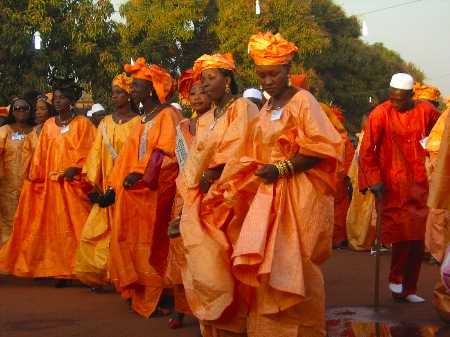 One may say, “I san bèe san bèe.” ‘Year after year’—may we meet this way again.
One may say, “I san bèe san bèe.” ‘Year after year’—may we meet this way again.
To which one may reply, “Fatigiya la, batigiya la, korotigiya la. San nyogon kèmè an ka jè ka seli nyogon fè.” ‘With our fathers, mothers, and older siblings. For a hundred years may we meet to pray together.’
Tabaski is about a real kind of love that fills the belly, makes one shine, and keeps everyone—no matter how little—safe when out and about. It radiates Allah’s mercy, returning year after year and, sometimes—and perhaps most satisfyingly—, when one least expects it.
By the end of the day, it seemed that I had accomplished something over the past month after all. I had made friends for a lifetime.

